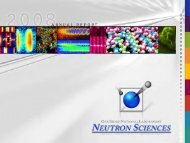PERFORMANCE INDICATORS FOR RESEARCH REACTORS
PERFORMANCE INDICATORS FOR RESEARCH REACTORS
PERFORMANCE INDICATORS FOR RESEARCH REACTORS
Create successful ePaper yourself
Turn your PDF publications into a flip-book with our unique Google optimized e-Paper software.
<strong>PER<strong>FOR</strong>MANCE</strong> <strong>INDICATORS</strong><br />
<strong>FOR</strong><br />
<strong>RESEARCH</strong> <strong>REACTORS</strong><br />
Greg Storr & Mark Summerfield
Performance<br />
What does it mean?<br />
� Measuring how an activity is done<br />
� Success or Failure<br />
� Doing your best<br />
� Living up to expectations<br />
� “Going the extra mile”<br />
� Receiving an ovation<br />
� Winning the U/11B football (soccer) premiership<br />
� Safe and well utilised facility
� Winning<br />
� How you played<br />
� Personal best<br />
� Team success<br />
Measuring Performance<br />
� Quantitative demonstration of success factors in a<br />
business<br />
� U11Bs won 3-1in the Grand Final
OPAL
Performance at OPAL<br />
� Project<br />
Cost, Schedule, Licensing, Commissioning<br />
� Operation<br />
Commissioning, Availability, Reliability, Utilisation<br />
� Safety<br />
Safety Performance Indicators<br />
� Culture<br />
Culture Survey, Attitudes, Behaviours
Safety Performance Indicators (SPIs)<br />
� SPIs – from Nuclear Power Plant Safety Events<br />
TMI, Chernobyl � drove regulation to performance measurement<br />
� OPAL Operating Licence Condition<br />
Develop a set of SPIs to satisfaction of the CEO of ARPANSA<br />
� Reference to CNRA/CSNI, IAEA, WANO<br />
NPP based<br />
Research Reactors – guidance in this area not well<br />
developed
Guidance on Safety Performance<br />
� RRs are disparate in design, usage<br />
� Difficult to generalise<br />
� Standardising unlikely<br />
� Benchmarking is possible<br />
� International meetings and collaborations<br />
� Research Reactor Code of Conduct
OPAL SPIs - Approach<br />
o SPIs form part of a safety management system<br />
o Considering a range of indicators will lead to<br />
insight<br />
o Early warning for deterioration in performance<br />
o Targets – focus attention to drive improvement<br />
o Benchmark – international comparison
OPAL SPIs – attributes & areas<br />
� Clear definition<br />
� Easily understood<br />
� Timely indication of safety degradation<br />
� Reporting period allows timely corrections<br />
� REACTOR SAFETY<br />
� RADIATION SAFETY<br />
� INDUSTRIAL SAFETY<br />
� SAFETY MANAGEMENT
Unplanned Trips
Protection System
INES Level
OLC breaches
Staff contamination
Safety Performance Indicator<br />
Unplanned automa-c trips per 7000 hrs cri-cal<br />
Annual <br />
Goal<br />
May 10 June 10 July 10<br />
6 20.1 19.5 17.8<br />
Number of FRPS/SRPS actua-ons when cri-cal not genera-ng a reactor trip, <br />
rolling last 12 months 6 7 9 9.0<br />
Number of reportable events INES > 0, rolling last 12 months 0 1 1 1<br />
Number of INES events level 0, rolling last 12 months 4 2 2 2<br />
Number of INES level 0 or >0 with Human Factor as a principal cause rolling <br />
last 12 months 1 0.3 0.3 0.3<br />
Number of OLC breaches, rolling last 12 months 0 0 0 0<br />
Number of unplanned -mes a limi-ng condi-on entered, rolling last 12 months 12 30 32 29<br />
Number of -mes unavailability detected during OLC SR, rolling last 12 months 3 10 10 9<br />
Maximum monthly PCS coolant ac-vity (µSv/hr) 1500 961 1155 1903<br />
Maximum individual effec-ve dose mSv/yr, rolling last 12 months
OPAL SPIs - outcomes<br />
� Using SPIs for about 2 years<br />
� Overall SPIs have been useful<br />
� Some SPIs may require redefinition<br />
� Some targets may need to be reset<br />
� “Leading” indicators required<br />
� Possible change to 12 month rolling basis<br />
� Review conducted by Nuclear Regulator<br />
� More maintenance related indicators
Leading indicators<br />
� AECL – 7 leading and 7 lagging indicators<br />
� Leading indicators<br />
� Self-assessments, Work Permit compliance<br />
� Observation and coaching,<br />
� Safety related system surveillance, Housekeeping tours<br />
� Safety research* – cause/consequence<br />
relationship may not be adequately captured<br />
� Activities and Outcomes based indicators may be<br />
a better way to define #<br />
• * A. Hopkins, L. Harms-Righdhal, both in Safety science Vol 47, 2009<br />
• # OECD, Guide on Safety Performance Indicators, 2003
Other indicators<br />
� Variety of inputs and trending needed in an<br />
integrated management system to improve<br />
performance<br />
� Investigations required to understand the nature<br />
of events and the underlying safety trends<br />
� Operational performance
Other indicators<br />
� Risk-based performance indicators<br />
� Qualitative cultural indicators – monitoring & tracking<br />
problematic<br />
� Using PSAs for NPPs<br />
� Model<br />
� Initiating events<br />
� Reliability of systems, trains, components<br />
� Mitigation potential of engineering systems<br />
� Mitigation potential of emergency actions<br />
� Indicators impacting (a) hardware (b) personnel<br />
� Review event reports & review reliability data*<br />
* S. Chakraborty et.al. Risk based Safety Performance Indicators for Nuclear Power Plants,<br />
SmiRT, 2003
The Future<br />
� OPAL – workshop with Nuclear Regulator –<br />
review and improve<br />
� Staff engagement and input<br />
� Discuss with other operators the possibility of a<br />
defined set of PIs for Research Reactors<br />
� Investigate whether the Research Reactor Code<br />
of Conduct could be used as a vehicle for this
Excellent training and coach<br />
Cohesive team<br />
Supportive club<br />
Train and develop staff<br />
Build a culture that is aligned<br />
Management are supportive<br />
CONCLUSION

















